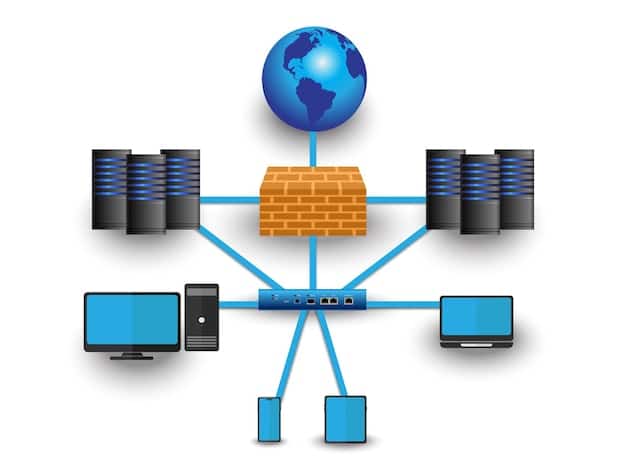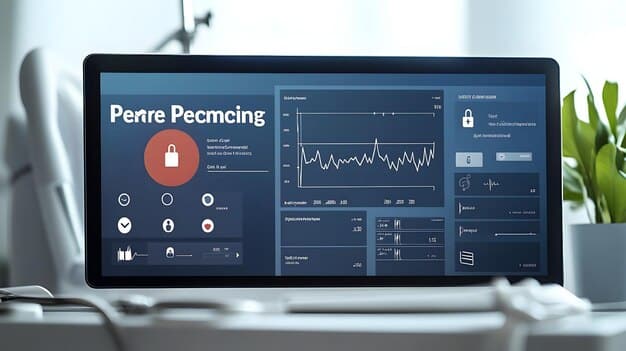SIEM Integration: Maximize Threat Detection in the US

SIEM integration centralizes log management and correlation to enhance threat detection capabilities, providing US organizations with a comprehensive security overview, improved incident response, and strengthened compliance through real-time analysis and actionable insights.
In today’s complex digital landscape, US organizations need robust security measures to combat evolving cyber threats. SIEM Integration: Maximizing Threat Detection Capabilities with Centralized Log Management and Correlation in US offers a strategic approach to identify and mitigate risks effectively.
Understanding SIEM Integration for US Threat Detection
Security Information and Event Management (SIEM) integration has become essential for US organizations looking to improve their threat detection capabilities. By combining centralized log management and correlation, SIEM systems offer a comprehensive view of security events across the IT infrastructure.
This integrated approach not only streamlines security operations but also enhances the ability to identify and respond to potential threats in real time. Let’s delve into how SIEM integration transforms threat detection for businesses operating in the US.
The Core Components of SIEM
At its core, a SIEM system encompasses two primary functions: Security Information Management (SIM) and Security Event Management (SEM). SIM involves the long-term storage, analysis, and reporting of log data, while SEM focuses on real-time monitoring, event correlation, and incident response.
The Benefits of Centralized Log Management
Centralized log management is a crucial aspect of SIEM integration. It involves collecting logs from various sources, such as servers, network devices, and applications, into a single repository. This centralization simplifies log analysis and aids in identifying patterns that may indicate malicious activity.
- Improved Visibility: Centralized logging provides a comprehensive view of all security events across the organization.
- Simplified Compliance: It helps meet regulatory requirements by ensuring all relevant logs are stored and accessible.
- Enhanced Threat Detection: Makes it easier to correlate events and identify potential threats that might otherwise go unnoticed.
In summary, understanding the core components and benefits of centralized log management is essential for US organizations seeking to enhance their threat detection capabilities through SIEM integration.

Optimizing Threat Detection with SIEM Correlation in the US
SIEM correlation is the process of analyzing and linking related security events to identify potential threats. By correlating events from different sources, SIEM systems can detect malicious activity that would be difficult to identify through individual log analysis.
For US organizations, optimizing threat detection with SIEM correlation involves configuring the system to recognize patterns and anomalies specific to their environment. Let’s explore the best practices for achieving this.
Configuring Correlation Rules
Correlation rules are the foundation of effective threat detection with SIEM. These rules define the conditions under which a security alert should be generated. They are typically based on specific event patterns, thresholds, or known indicators of compromise (IOCs).
Leveraging Threat Intelligence Feeds
Threat intelligence feeds provide up-to-date information on known threats and vulnerabilities. By integrating these feeds into the SIEM system, organizations can proactively identify and respond to emerging threats. Threat intelligence also enhances the accuracy of correlation rules and reduces false positives.
- Improved Accuracy: Threat intelligence helps refine correlation rules, reducing false positives.
- Proactive Detection: Enables the identification of emerging threats before they cause damage.
- Contextual Insights: Provides additional information about the nature and severity of identified threats.
In conclusion, optimizing threat detection with SIEM correlation requires careful configuration of correlation rules and the integration of threat intelligence feeds to identify and respond to emerging threats effectively in the US.
Real-Time Monitoring and Incident Response in US Organizations
Real-time monitoring is a critical component of SIEM integration, enabling US organizations to detect and respond to security incidents as they occur. By continuously analyzing security events, SIEM systems can identify suspicious activity and generate alerts for immediate investigation.
Effective incident response is essential for minimizing the impact of security breaches. SIEM integration provides the tools and information needed to quickly assess the situation, contain the damage, and restore normal operations.
Setting Up Alerting Mechanisms
Alerting mechanisms are designed to notify security personnel when specific events or conditions occur. These alerts can be triggered by correlation rules, threshold violations, or other predefined criteria. Alerting mechanisms must be finely tuned to ensure that only genuine threats trigger alerts.
Automating Incident Response Tasks
Automation plays a key role in streamlining incident response. SIEM systems can automate tasks such as isolating infected systems, blocking malicious IP addresses, and disabling compromised user accounts. This automation reduces the time required to respond to incidents and minimizes the potential damage.
- Faster Response Times: Automation reduces the time needed to respond to security incidents.
- Reduced Human Error: Automating tasks minimizes the risk of human error during incident response.
- Improved Efficiency: Security teams can focus on more complex tasks while the SIEM system handles routine incident response activities.
In summary, real-time monitoring and automated incident response tasks are crucial for US organizations to swiftly address security incidents, reducing potential damage and minimizing disruptions to normal operations.
Compliance and Reporting with SIEM in the US
Compliance is a significant concern for US organizations across various industries. SIEM integration supports compliance efforts by providing the tools needed to monitor and report on security-related activities.
By centralizing log data and automating reporting processes, SIEM simplifies compliance audits and ensures that organizations meet regulatory requirements. Moreover, customized reports can be generated to demonstrate adherence to specific compliance frameworks, such as HIPAA, PCI DSS, and NIST.
Meeting Regulatory Requirements
SIEM helps meet regulatory requirements by providing detailed audit trails of security events. These audit trails can be used to demonstrate compliance with regulations such as HIPAA, PCI DSS, and NIST. Custom reports are created, which show compliance with those regulatory measures.
Generating Custom Reports
SIEM systems can generate custom reports tailored to specific compliance requirements. These reports provide a clear and concise overview of security activities, making it easier to demonstrate compliance to auditors. Generating custom reports can be done in a quick and efficient manner.

- Streamlined Audits: SIEM simplifies compliance audits by providing easy access to security-related data.
- Reduced Costs: Automation of reporting processes reduces the costs associated with compliance.
- Improved Security Posture: Continuous monitoring and reporting helps identify and address security gaps.
To summarize, compliance and reporting with SIEM systems are essential for US organizations to meet regulatory requirements, streamline audits, and continuously improve their overall security posture.
Challenges and Considerations for SIEM Implementation in the US
While SIEM integration offers numerous benefits, US organizations may face challenges during implementation. These challenges include selecting the right SIEM solution, integrating it with existing systems, and managing the large volumes of log data generated.
Addressing these challenges requires careful planning, expertise, and ongoing maintenance. Let’s look deeper into how to overcome these challenges.
Selecting the Right SIEM Solution
Choosing the right SIEM solution is crucial for success. Organizations should carefully evaluate their requirements and select a solution that meets their specific needs and budget. Things to consider are costs, needs analysis, and the size of the organization amongst others.
Integrating with Existing Systems
Integrating the SIEM system with existing security and IT systems can be complex. Organizations should plan the integration carefully and ensure that all systems are compatible. Comprehensive testing and good integration skills will ensure positive outcomes.
- Data Overload: Managing the large volumes of log data generated by SIEM systems can be challenging. Proper planning and optimization are essential.
- Complexity: Implementing and managing a SIEM system requires expertise. Organizations may need to hire or train skilled personnel.
- Cost: The cost of SIEM solutions can be significant, including software licenses, hardware, and personnel costs.
In conclusion, US organizations need to carefully address these challenges and considerations for smooth and effective SIEM implementation, ensuring the benefits of enhanced threat detection and compliance.
The Future of SIEM and Threat Detection in the US
The future of SIEM and threat detection in the US is likely to be shaped by advancements in artificial intelligence (AI), machine learning (ML), and cloud computing. These technologies will enable SIEM systems to automate more tasks, improve accuracy, and scale to meet the growing demands of organizations.
Embracing these advancements will be crucial for US organizations looking to stay ahead of emerging threats. Let us explore this further below.
AI and Machine Learning in SIEM
AI and ML can enhance SIEM capabilities by automating threat detection, reducing false positives, and providing more accurate insights. AI and ML can provide many benefits for security specialists by creating new innovative systems.
Cloud-Based SIEM Solutions
Cloud-based SIEM solutions offer scalability, flexibility, and cost-effectiveness. These solutions can be easily deployed and managed, making them attractive to organizations of all sizes. Moving to the cloud offers many benefits in our modern world.
- Enhanced Automation: AI and ML will enable SIEM systems to automate more tasks, such as threat detection and incident response.
- Improved Accuracy: AI and ML will reduce false positives and provide more accurate insights into security incidents.
- Scalability: Cloud-based SIEM solutions will offer scalability and flexibility, allowing organizations to easily adapt to changing needs.
Therefore, the future of SIEM and threat detection in the US lies in embracing these technological advancements, making threat detection more efficient, accurate, and scalable for organizations.
| Key Point | Brief Description |
|---|---|
| 🛡️ Centralized Log Management | Collects logs from various sources into a single repository for easier analysis. |
| 🔍 SIEM Correlation | Analyzes and links related security events to identify potential threats. |
| 🚨 Real-Time Monitoring | Detects and responds to security incidents as they occur. |
| ⚙️ Automation | Reduces response times by implementing automated tasks. |
Frequently Asked Questions
▼
SIEM integration combines Security Information Management (SIM) and Security Event Management (SEM) to centralize log data and enhance threat detection, providing comprehensive security insights.
▼
SIEM improves threat detection by correlating events from various sources, identifying patterns that suggest malicious activity, and providing real-time alerts for immediate investigation.
▼
Centralized log management offers improved visibility, simplified compliance, and enhanced threat detection by consolidating logs from diverse systems into a single, easily accessible repository.
▼
SIEM supports compliance by providing detailed audit trails, generating custom reports, and simplifying audits, ensuring adherence to regulatory requirements like HIPAA and PCI DSS.
▼
Future trends in SIEM include the integration of AI and machine learning for automated threat detection, cloud-based SIEM solutions for scalability, and improved accuracy in identifying security incidents.
Conclusion
In conclusion, SIEM integration offers a robust solution for US organizations to maximize their threat detection capabilities through centralized log management and correlation. By implementing these strategies and embracing future trends, businesses can better protect their digital assets and maintain a strong security posture in an ever-evolving threat landscape.





